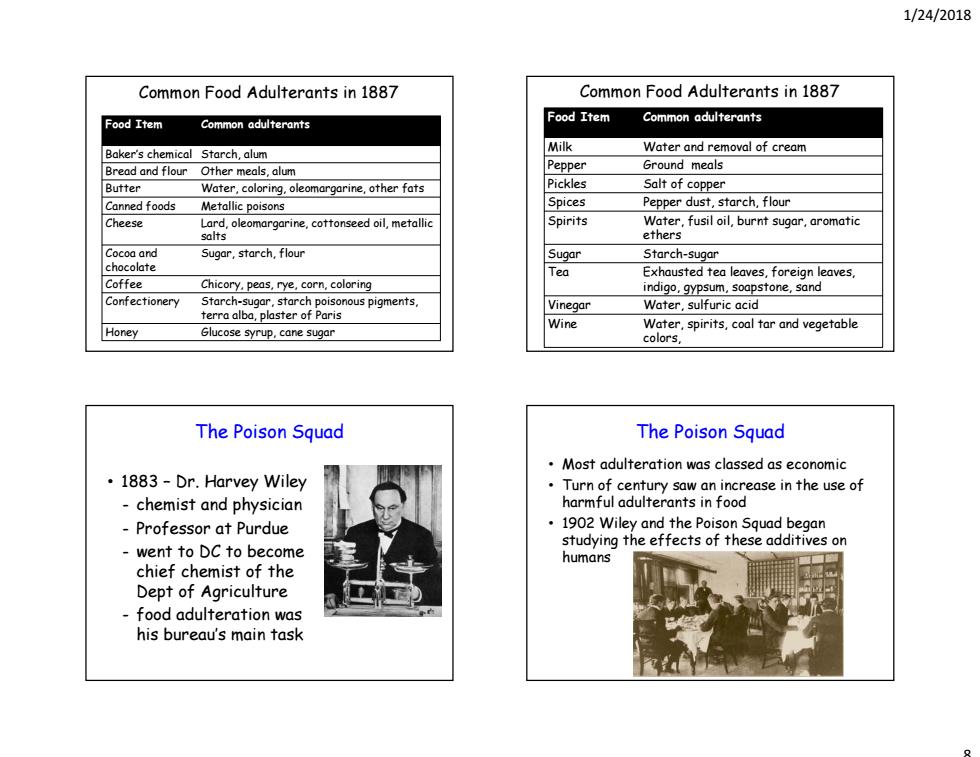正在加载图片...

1/24/2018 Common Food Adulterants in 1887 Common Food Adulterants in 1887 Food Item Common adulterants Food Item Common adulterants Baker's chemical Starch,alum Milk Water and removal of cream Bread and flour Other meals,alum Pepper Ground meals Butter Water,coloring.oleomargarine,other fats Pickles Salt of copper Canned foods Metallic poisons Spices Pepper dust,starch,flour Cheese Lard,oleomargarine.cottonseed oil,metallic Spirits Water,fusil oil,burnt sugar,aromatic salts ethers Cocoa and Sugar,starch,flour Sugar Starch-sugar chocolate Tea Exhausted tea leaves,foreign leaves, Coffee Chicory.peas,rye,corn,coloring indigo,gypsum,soapstone,sand Confectionery Starch-sugar,starch poisonous pigments, Vinegar Water,sulfuric acid terra alba,plaster of Paris Wine Honey Glucose syrup,cane sugar Water,spirits,coal tar and vegetable colors, The Poison Squad The Poison Squad Most adulteration was classed as economic 1883-Dr.Harvey Wiley Turn of century saw an increase in the use of -chemist and physician harmful adulterants in food -Professor at Purdue 1902 Wiley and the Poison Squad began studying the effects of these additives on -went to DC to become humans chief chemist of the Dept of Agriculture food adulteration was his bureau's main task 1/24/2018 8 Food Item Common adulterants Baker’s chemical Starch, alum Bread and flour Other meals, alum Butter Water, coloring, oleomargarine, other fats Canned foods Metallic poisons Cheese Lard, oleomargarine, cottonseed oil, metallic salts Cocoa and chocolate Sugar, starch, flour Coffee Chicory, peas, rye, corn, coloring Confectionery Starch-sugar, starch poisonous pigments, terra alba, plaster of Paris Honey Glucose syrup, cane sugar Common Food Adulterants in 1887 Food Item Common adulterants Milk Water and removal of cream Pepper Ground meals Pickles Salt of copper Spices Pepper dust, starch, flour Spirits Water, fusil oil, burnt sugar, aromatic ethers Sugar Starch-sugar Tea Exhausted tea leaves, foreign leaves, indigo, gypsum, soapstone, sand Vinegar Water, sulfuric acid Wine Water, spirits, coal tar and vegetable colors, Common Food Adulterants in 1887 • 1883 – Dr. Harvey Wiley - chemist and physician - Professor at Purdue - went to DC to become chief chemist of the Dept of Agriculture - food adulteration was his bureau’s main task The Poison Squad • Most adulteration was classed as economic • Turn of century saw an increase in the use of harmful adulterants in food • 1902 Wiley and the Poison Squad began studying the effects of these additives on humans The Poison Squad